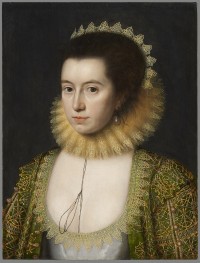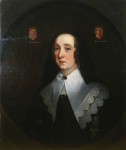 A portrait of the redoubtable Lady Anne Clifford long thought lost has been purchased by the National Portrait Gallery for £275,000 ($444,428). The portrait was known to have existed because Lady Anne, a dedicated diarist her entire life, wrote about having sat for artist William Larkin in the summer of 1618. She was 28 years old at the time and married to Richard Sackville, 3rd Earl of Dorset. Larkin made two versions of the portrait, one of which was kept at the Sackville estate in Knole, Kent, where it remains to this day. The other Anne gave to her mother’s first cousin, Margaret Hall of Gretford, Lincolnshire. It stayed in the Margaret’s family until the 19th century when it was auctioned as Portrait of Lady Goodrick Parke by Federico Zuccaro. It was sold again in 1956 to a German art dealer. From there it went into a German private collection which is where Mark Weiss, director of the Weiss Gallery in London, found it last year and identified it as the long-lost Larkin portrait of Lady Anne Clifford.
A portrait of the redoubtable Lady Anne Clifford long thought lost has been purchased by the National Portrait Gallery for £275,000 ($444,428). The portrait was known to have existed because Lady Anne, a dedicated diarist her entire life, wrote about having sat for artist William Larkin in the summer of 1618. She was 28 years old at the time and married to Richard Sackville, 3rd Earl of Dorset. Larkin made two versions of the portrait, one of which was kept at the Sackville estate in Knole, Kent, where it remains to this day. The other Anne gave to her mother’s first cousin, Margaret Hall of Gretford, Lincolnshire. It stayed in the Margaret’s family until the 19th century when it was auctioned as Portrait of Lady Goodrick Parke by Federico Zuccaro. It was sold again in 1956 to a German art dealer. From there it went into a German private collection which is where Mark Weiss, director of the Weiss Gallery in London, found it last year and identified it as the long-lost Larkin portrait of Lady Anne Clifford.
The National Portrait Gallery bought the portrait with a £70,000 grant from the Art Fund, £45,000 in private donations and £160,000 from its own acquisitions budget. This painting of Lady Anne as a young woman joins just one other portrait of her in the NPG collection. It’s a copy after an original by Sir Peter Lely painted around 1646 when Lady Anne was 56.
 Larkin’s portrait captures Anne in a dark period in her life. Early in 1618 she gave birth to a baby who died. In deep mourning, she refrained from writing in her diary for the entire year. She sat for William Larkin that summer. You can see the signs of mourning in the portrait. Those black strings hanging from her neck and left ear are mourning strings. She began writing in her diary again on January 1619. That’s when she refers to the portrait:
Larkin’s portrait captures Anne in a dark period in her life. Early in 1618 she gave birth to a baby who died. In deep mourning, she refrained from writing in her diary for the entire year. She sat for William Larkin that summer. You can see the signs of mourning in the portrait. Those black strings hanging from her neck and left ear are mourning strings. She began writing in her diary again on January 1619. That’s when she refers to the portrait:
The first of this month I began to have the curtain drawn in my chamber and to see the light… The 16th… I sent my cousin Hall of Gilford [sic.] a letter and my picture with it which Larkin drew at Knole this summer.
That first line is a reference to her coming out of mourning, having the curtains drawn to let the light into her room for the first time since the death of her baby. Her description of Larkin coming to paint her at Knole is noteworthy because it means he was welcomed into high aristocratic circles. The other portraits by Larkin in the National Portrait Gallery (Frances Howard, Countess of Somerset, and George Villiers, First Duke of Buckingham) were both painted in his London studio. They both predate the Clifford portrait and are markedly inferior in quality. That Anne Clifford, a noble and influential patron of the arts, invited Larkin to paint her in situ means he had well and truly arrived.
Larkin certainly captured her beauty and verve, at least according to her description. Here is Lady Anne’s self-assessment from her diary:
The colour of mine eyes were black, like my father, and the form and aspect of them was quick and lively, like my mother’s; the hair of my head was brown and very thick, and so long that it reached to the calf of my legs when I stood upright, with a peak of hair on my forehead and a dimple in my chin like my father, full cheeks and round face like my mother, and an exquisite shape of body resembling my father.
 Low self-esteem was not her problem, and bless her for it because she was a genuine unstoppable badass. She spent 38 years fighting for the birthright her father had denied her after he bequeathed the title and estates to his brother instead of his 15-year-old daughter. She finally succeeded when she was 53 years old and her cousin Henry, son of the brother who had inherited, died. In the interim, she used her extensive education, meticulous record-keeping and impressive multi-tasking ability to run estates while her husbands gambled, drank and whored their lives away.
Low self-esteem was not her problem, and bless her for it because she was a genuine unstoppable badass. She spent 38 years fighting for the birthright her father had denied her after he bequeathed the title and estates to his brother instead of his 15-year-old daughter. She finally succeeded when she was 53 years old and her cousin Henry, son of the brother who had inherited, died. In the interim, she used her extensive education, meticulous record-keeping and impressive multi-tasking ability to run estates while her husbands gambled, drank and whored their lives away.
The metaphysical poet John Donne said of Lady Anne that “she knew well how to discourse of all things, from predestination to slea-silk.” (Slea-silk is a kind of floss silk that can be separated into filaments for use as embroidery thread.) She also knew how to get her way even if it meant spending decades in litigation or going head-to-head with Oliver Cromwell to rebuild Clifford properties damaged during the Civil War.
Read this entry to get the full scoop on Lady Anne’s colorful life and why she’s become a proto-feminist icon.